
Home
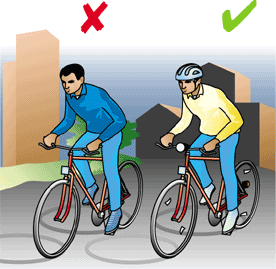
IMPORTANT: NEVER USE A DAMAGED
HELMET OR ONE WHICH HAS BEEN INVOLVED IN AN ACCIDENT
Hints and tips
- Wear a cycle helmet.
- Wear bright coloured or fluorescent clothing to help increase your visibility to other road users and pedestrians.
- Remember to dress according to the weather. Wearing layers is advisable so that clothing can be removed or added as needed.
- Wear sun block when
cycling in the summer, even when cloudy,
the sun may be stronger than you think.
DO:
- Wear fluorescent material during the day.
- Wear reflective material at night and in dull/bad weather conditions.
- Tie back long hair as it
can blow over your face and stop
you seeing properly. - Wear layers of clothing and ensure you are protected from the weather.
- Wear comfortable clothing.
Check your bike.
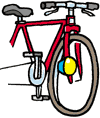 Make
sure your front and back lights work well, and your back
reflector is clean.
Make
sure your front and back lights work well, and your back
reflector is clean.When you have to carry anything on your cycle, use a bike bag or panniers. Make sure that your
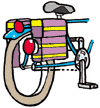 clothing
or anything else does not get caught in the chain or wheels.
clothing
or anything else does not get caught in the chain or wheels. ¡@
BEFORE YOU SET OFF
Make sure your cycle is safe to ride - your brakes are working well and your tyres are in good condition.
Always wear a cycle helmet - it will help to protect you if you have an accident.
Make sure that other road users can see you. Wear fluorescent materials in daylight and at dusk, and something reflective at night.
Riding a bike which is too big or small can affect your balance and can be dangerous.
CYCLING IN THE DARK
Wear fluorescent clothes in the daytime and reflective clothes in the dark.
It is an offence to cycle at night without a white front light, a red back light and a red reflector at the back, so make sure they are clean and working.
Remember that if you have a
dynamo on your bike your lights will go out when you stop.
¡@
ON YOUR BIKE
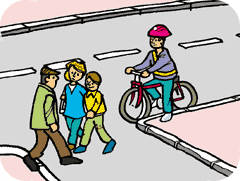
Before starting off, turning right or left, overtaking, or stopping, you must look behind and make sure it is safe and then give a clear arm signal to show what you intend to do.
You must not ride on the pavement unless there are special signs allowing you to do so.
When you get on your cycle look all round for traffic. When it is safe to move off, cycle away.
Always keep both hands on the handlebars unless you are signalling or changing gears.
When turning from one road into another, pedestrians who are crossing that road have the right of way, so give way.
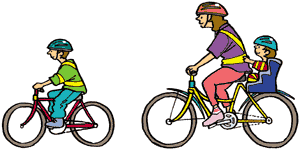
You must obey traffic light signals made by police officers, traffic wardens or school crossing patrols.
You must not hold onto a vehicle or another cyclist.
You must not carry a passenger on you cycle unless it is specially designed to do so.
You should never lead an animal whilst cycling.
Watch out for traffic doing unexpected things.
If riding with others on a busy
or narrow roads, you should ride one behind the other. Never ride more
than two side by side.
¡@
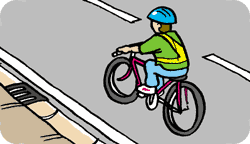
Ride far enough from the edge of the road to avoid drains and gutters.
If you want to turn right from a busy road, it is safer to stop on the left hand side before or after the junction and wait for a safe gap in the traffic, before walking with your cycle across the road.
You should not wear a personal
stereo whilst cycling or use a mobile phone.
Only overtake when you are certain it is safe to do so. If you are overtaking parked vehicles, watch out for them starting off while you are doing so, look out for car doors opening or pedestrians crossing near to them. You should also look for traffic coming towards you.
PARKING YOUR CYCLE
Always park your cycle thoughtfully so that it is not in the way of other people. It is best to use a cycle rack if one has been provided.
Lock it to prevent it being stolen and have the frame marked with your postcode.
PEDESTRIAN CROSSINGS
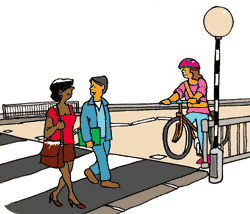
You must stop for pedestrians at Zebra crossings.
You must stop for the red light at traffic lights, including those at crossings.
CYCLING NEAR ANIMALS
Be careful when cycling near horses and other animals. Give them plenty of room as you go by.
Don't scare them by sounding your bell or horn, it could cause an accident.
CYCLE ROUTES AND CROSSINGS
The signs below show the different paths
 |
 |
 |
|
Recommended route
for pedal cycles
|
Cycles only
|
Shared with
pedestrians
|
 |
 |
|
Separate cycle and
pedestrians
|
Cycle lane
|
Where available, always use routes away from busy roads. In some areas special cycle routes, paths and lanes are provided.
BUS LANES
 |
Only cycle in bus lanes if there is a cycle shown on the sign. Be aware that cycles are not always seen in cycle lanes. |
ROUNDABOUTS
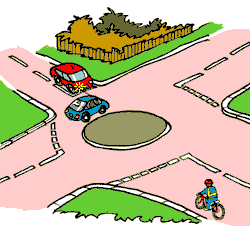
At roundabouts get off your cycle and walk if you feel unsafe. When entering a roundabout you must give way to traffic coming from your right. Look out for vehicles which may turn in front of you.
DON'T CYCLE

This sign means no cycling.
REMEMBER
Look after your bike and make
sure it is safe
Make sure that you are dressed in the right clothes:
- Light clothes
- Pads and a helmet
- Make sure that you can always see and hear well.
Signals given by drivers
ARM SIGNALS
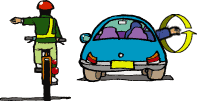 |
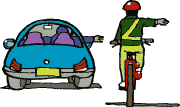 |
|
I intend to
move in to the left lane or turn left
|
I intend to
move in to the right lane or turn right
|
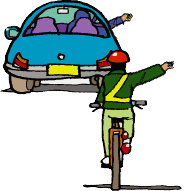 |
|
I intend to
slow down or stop.
(Particularly useful at Zebra crossings) |
¡@



